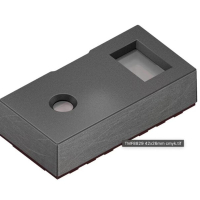dToF sensor boosts resolution for 3D spatial detection

The TMF8829 dToF sensor from ams OSRAM significantly increases resolution from the previously standard 8×8 zones to 48×32. Furthermore, the direct Time-of-Flight (dToF) sensor is capable of detecting subtle spatial differences and distinguishing closely spaced or slightly varied objects.
For example, the dToF sensor can tell whether an espresso cup or a travel mug is placed under a coffee machine, ensuring the correct amount is dispensed every time. This kind of precision is critical for a broad spectrum of applications — from logistics robots that distinguish between nearly identical packages, to camera systems that maintain focus on moving objects in dynamic video scenes.
“The new dToF sensor supports precise 3D detection and differentiation in diverse applications — without a camera and with stable performance across varying targets, distances, and environmental conditions,” says David Smith, Product Marketing Manager at ams OSRAM.
New benchmark for dToF sensor technology
The dToF sensor emits infrared light pulses and then uses the reflections of light from these pulses to calculate the distance to an object, much like how the delay of an echo reveals distance. Multi-zone sensors enhance this by capturing reflected light from multiple viewing angles (zones), like a network of echo points, enabling the creation of detailed 3D depth maps.
The TMF8829 divides its field of view into up to 1,536 zones, a significant improvement over the 64 zones in standard 8×8 sensors. This higher resolution enables finer spatial detail. For example, the dToF sensor supports people counting and presence detection in smart lighting systems, object detection and collision avoidance in robotic applications, and intelligent occupancy monitoring in building automation. The detailed depth data also provides a foundation for machine learning models that interpret complex environments and enable intelligent interaction with surroundings.
Measuring just 5.7 × 2.9 × 1.5 mm, thinner than a cent coin and more compact than typical sensors with lower resolution, the TMF8829 delivers high resolution in a format ideal for space-constrained devices. Because it operates without a camera, it supports privacy-sensitive applications. When paired with a camera, the sensor enables hybrid vision systems, such as RGB Depth Fusion, which combines depth and colour data for AR applications, including virtual object placement.
Classified as a Class 1 eye-safe device, the TMF8829 uses a dual VCSEL (Vertical Cavity Surface Emitting Laser) light source to measure distances up to 11 meters with 0.25 mm precision — sensitive enough to detect subtle movements like a finger swipe. With its 48×32 zones, the sensor covers an 80° field of view, delivering depth information across a scene comparable to that of a wide-angle lens. On-chip processing reduces latency and simplifies integration. Instead of relying on a single signal, the sensor builds a profile of returning light pulses to identify the most accurate distance point — ensuring stable performance even with smudged cover glass. Complete histogram output supports AI systems in extracting hidden patterns or additional information from the raw signal.
